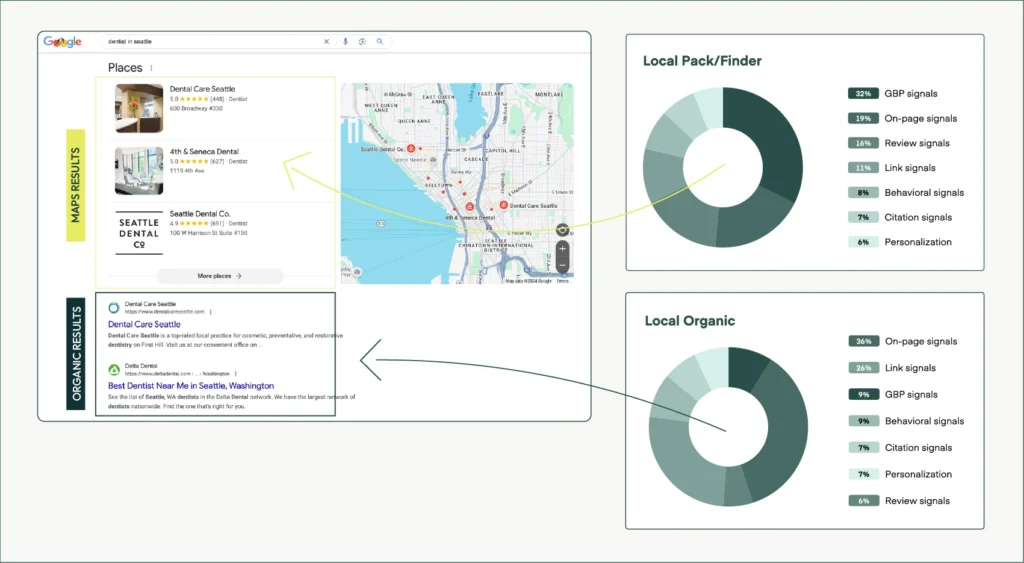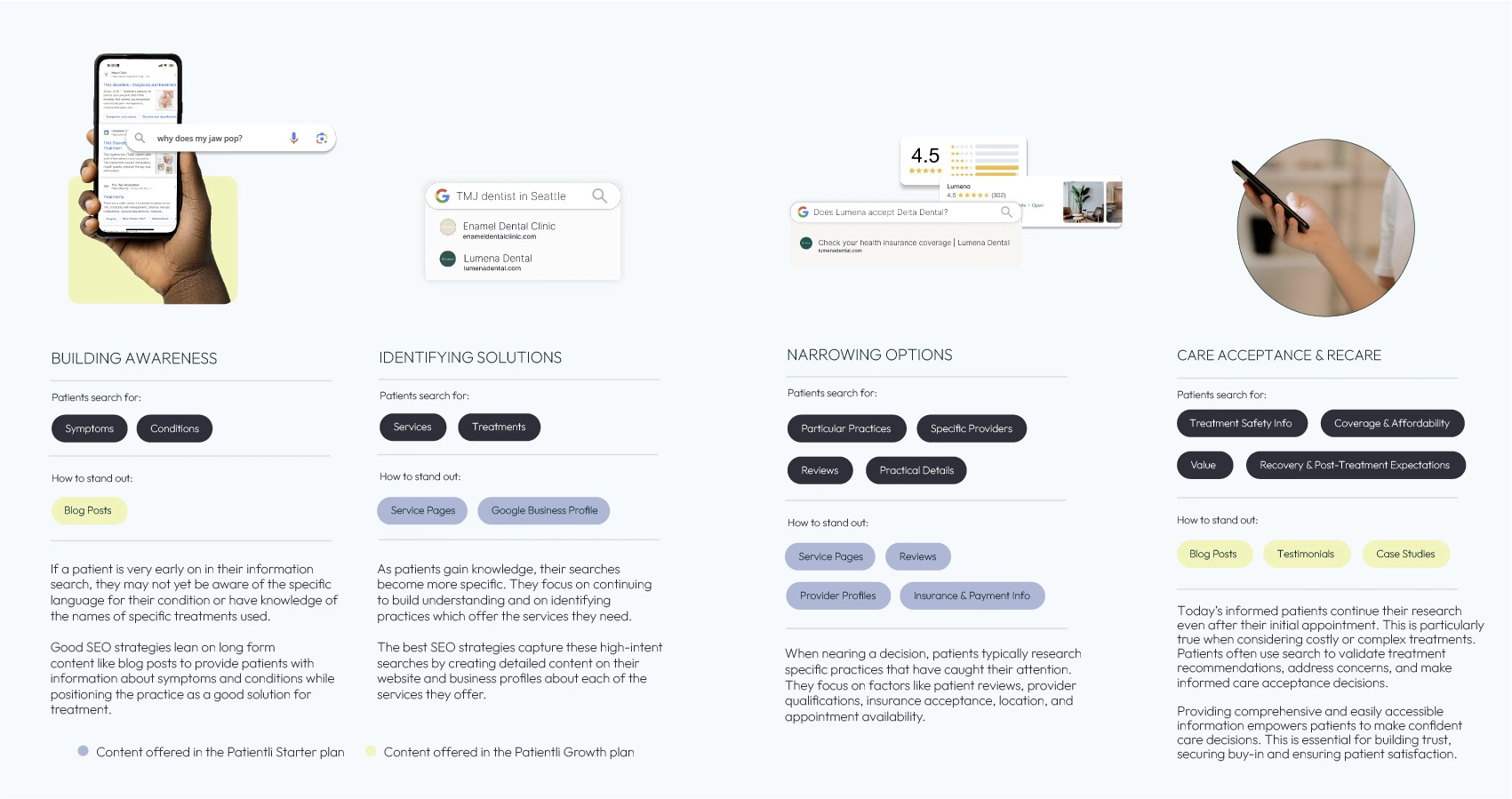Exploring DSO Brand Structure: The Pros & Cons of Branded vs Unbranded DSOs
Two Approaches to Branding for DSOs: Choosing the Right Strategy for Your Organization When launching a Dental Service Organization (DSO), one of the most important
Marketing & SEO
What is SEO? And how is it actually done?

With over three quarters of patients using online searches in their patient journey, search engine optimization is a marketing tactic that healthcare practices can’t ignore. But a lack of understanding among providers about what SEO is, how it’s done and how to measure its effectiveness has resulted in an industry awash with companies that aren’t always known for their results or honesty. Use this quick guide to get up to speed on how to make the best decisions for your business about this all-important tactic.

SEO, or Search Engine Optimization, is a strategy focused on enhancing your practice’s online visibility on search engines like Google. When a patient performs a search for a dentist in their town or keys in a symptom or name of a treatment they’ve heard, a search engine will aim to return the most relevant results in the form of a list of links to website pages that deliver the information the patient is searching for. SEO aims to ensure your practice appears prominently when a patient’s search matches what you offer, resulting in a far higher chance that the patient will engage with your website, consider you as a good option for their care and book an appointment. Naturally, every business who’s heard of SEO wants their business to appear at the top of these results, so competition for this visibility can be intense.
Unlike other advertising channels, search engines are intent-based channels. This means people use them with a clear purpose—usually to find solutions or gather information. With intent-based channels, users are typically closer to making a decision and more likely to follow through with an action, like scheduling an appointment. This is in contrast to awareness-based channels, such as social media or traditional advertising, where users encounter your brand more passively and may or may not be in the frame of mind to follow through on becoming a patient.
Both intent-based and awareness-based tactics play important roles in a marketing plan that’s built around the patient journey. Awareness-based channels help keep your practice top-of-mind, but SEO offers the highest return on investment and provides long-term benefits, making it one of the first strategies we recommend to healthcare practices.
It’s hard to overstate the importance of search engines in the patient journey. Each year, a mind-blowing 100 billion healthcare-related Google searches are made. This provides healthcare marketers with a lot of aggregated data to help us understand the patient decision-making process. Here are a few insights:
the number of health-related searches made on Google annually
Patients who end up booking appointments performed 3x more searches than those who didn’t
Source: Google
The modern patient journey is highly personalized. Patients actively research their health concerns symptoms and treatment options online, conducting numerous searches before making decisions. A Google study on the patient’s journey to care noted that study participants followed 4,000 unique search paths!
Patients who book appointments use search more than those who don’t. Most patients begin their healthcare journey online, with search engines being their primary starting point (77%). Highly engaged patients, particularly those who book appointments, rely heavily on search, conducting 3x more searches than those who don’t. Google data reveals that appointment-bookers typically perform 15 searches before making a decision, highlighting significant online engagement and presenting numerous opportunities for healthcare businesses to be discovered and considered by potential patients.
Search behavior evolves throughout the patient journey, with the type of queries a patient makes following common patterns as they amass more information and get nearer to making a care decision. Understanding these shifts allows practices to optimize their online presence and attract potential patients at every stage. Effective SEO strategies take advantage of this dynamic by focusing on creating valuable website content that aligns with the evolving information needs of patients as they move closer to making a care decision.
The internet has allowed patients to chart their own search path, keying in whatever question they’re looking to answer. The result is that patient journeys have become personal and unique. However, research tells us a lot about how patients use search, how that differs depending on their level of familiarity with the decision they’re trying to make and how close they are to taking action.
According to a study done by Google, patients who book an appointment perform, on average, 15 searches before committing to a care option. The number of searches a patient performs is a good indicator for how engaged they are in finding a care provider, with patients who end up booking averaging 3x more searches than those who don’t. We also know that the types of information patients search for change as they get closer to making a decision.
Taken together, these insights give your practice multiple opportunities to capture a patient’s attention and make it into the set of options they’re seriously considering. Good SEO strategies are crafted in this way and aim to appear in searches with website content that’s created with the intention of appearing at some or all of the phases of a patient’s likely information search path.

What patients search for: Symptoms and conditions
What content stands out: informational content like blogs
If a patient is very early on in their information search, they may not yet be aware of the specific language for their condition or have knowledge of the names of specific treatments used. For example, a patient early in their information search is likelier to search for symptom-related words or phrases, like “why does my jaw pop?”.
What patients search for: services and treatments
What content stands out: service pages and provider profiles
Patients who are closer to making a decision tend to perform searches that demonstrate they have a better understanding of what they’re looking for, moving towards searches that mention specific treatment names, for example “TMJ treatment options,” or “TMJ dentists near me.” Searches in this stage help patients fill out what marketers call the consideration set, or more simply, the short list of options they plan to research in more depth.
What patients search for: particular practice names
What content stands out: reviews, case studies, provider profiles and practical information
Patients in their decision stage narrow their choices by researching specific practices that have stood out to them and logistical information that relate to their decision criteria, like insurance acceptance, provider qualifications, location, and reviews.
What patients search for: information about safety, value and recovery
What content stands out: blog content that addresses concerns & objections, testimonials
Today’s patients even use search after an appointment, especially if unexpected treatment is recommended at their appointment. 83% of millennials validate treatment recommendations with online search after an appointment.
What does this mean for healthcare business owners? Creating and optimizing website content that’s designed to answer questions and fill needs that patients have at each stage of their search process is the best way to get in front of patients when they’re actively looking for a provider.

Two Approaches to Branding for DSOs: Choosing the Right Strategy for Your Organization When launching a Dental Service Organization (DSO), one of the most important
Starting a dental service organization (DSO) is no small feat. In the crowded dental market, standing out requires more than just high-quality care—it requires a
It’s hard to overstate the importance of search engines in the patient journey. Each year, a mind-blowing 100 billion healthcare-related Google searches are made. This